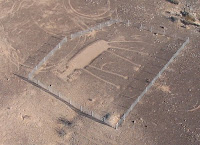Sharing the previous post generated a lot of pushback, surprisingly from a Facebook group on the Book of Mormon and archaeology. The suggestion that this particular figure of the geoglyphs in the southern California desert known today as the Blythe Intaglios could possibly be a horse was met primarily with criticism. The common answer was that it was a mountain lion and could not be a horse. Why would an animal design like this be identified with a predator like a puma or cougar and not some prey animal more closely resembling its actual shape?
 |
| the other Blythe Intaglios Quadruped |
The prevailing interpretation is that the humanoid figure is Mastamho, the creator of life. He had a companion and helper known as Hatakulya, a mountain lion. Some legends say that Hatakulya could also transform into a man. Other legends state that there were two mountain lions: Hatakulya and Numeta. Hatakulya has a tail that hangs down and Numeta has one that goes up over his back. If this interpretation is correct, then both quadrupeds would have to represent Hatakulya. These creation stories come from the Mohave and Quechan tribes that live in the region today.
This is the most common interpretation of these giant images, but in searching websites that explain or describe the Blythe Intaglios, most appear to have copied their text from the same source, as they all say the same thing. The quadrupeds are often described in scientific literature as 'mountain lion-like.' This is odd, because even if they do represent such an animal, they certainly do not look like mountain lions. This connection relies considerably on ethnographer Boma Johnson's work (1985, 2003). We can find no additional support for this idea; all later interpretations appear to be using Johnson's work as their reference. The human and animal figures are closely grouped together as though they had a symbolic connection. Each human/animal pair is traditionally identified as Mastamho and Hatakulya respectively, but since Hatakulya is a mountain lion that can transform into a man, perhaps each set represents both aspects of one being. Based on the accepted iconography, neither of the animals can be Numeta. A third humanoid is nearby, but without an accompanying animal.
LegendsofAmerica.com has a page on the Blythe Intaglios and repeats the same story as all the rest do, but also suggests that the figures instead may represent powerful individuals in a clan interacting with their surroundings. It also includes the observation that "Part of the dating problem is that the animal figures appear to be horses. If so, they must have been carved either before American horses went extinct some 10,000 years ago or more recently after the Spaniards arrived in California in 1540.
"Another theory holds that some modern horses did exist in North America before the Spaniards, but were regarded as food sources rather than bests [sic] of burden."
Our point is that it really is not clear what these figures were originally created to represent. Since no Native American group in the region claims to have made them, it is reasonable to look at alternative interpretations. We have seen several possibilities. The problem is, as LegendsofAmerica states, the animal figures (particularly one of them) appear to be horses. The two quadrupeds are not identical; they have some differing details, such as head shape, neck length, and suggestion of paws (or hooves) at the feet, one looking more horse-like than the other. We aren't stating definitively that they are horses, just that this idea is something to consider. We aren't the first to suggest this. They may be the mountain lion(s) that assisted in the creation, but if they are, we must ask why the people who made them did not make them look more like predators instead of prey animals, since ancient cultures in this region (and even worldwide) were certainly adept at doing that. Regardless of what the giant figures may represent or the role they played in their original culture, without the pre-conceived idea that they are mountain lions in a specific creation story, any untrained observer would classify them as some sort of large prey animal, likely an ungulate.







.jpeg)




